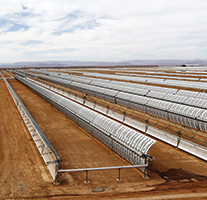World leaders meet in Paris on Monday for the latest round of talks on reducing carbon emissions. Differences between rich and poor countries threaten the search for solutions
It will be one of the greatest ironies of history, when history finally comes to a close, that the biggest problem ever to beset the human race came with a very simple solution, yet proved excessively difficult to solve. That problem is global climate change, which threatens to make the Earth uninhabitable for people. Next week all the nations of the world will come together for a fortnight’s conference in Paris, to try to solve it.
The solution on offer is simplicity itself: stop burning the fossil fuels coal, oil and gas, whose principal waste product, carbon dioxide, is increasing remorselessly in the atmosphere and steadily retaining more and more of the sun’s heat. Yet putting that solution into practice is proving nigh impossible.
The Paris meeting, known in United Nations jargon as COP21 – it is the twenty-first conference of the parties to the United Nations Framework Convention on Climate Change, the UNFCCC, signed at the Earth Summit in Rio in 1992 – has been painstakingly prepared for over five years, and the hopes riding on it are colossal.
This great climate jamboree, attended by most of the world’s leaders from President Barack Obama down – and a security nightmare in the wake of the Islamic State attacks two weeks ago – will try to assemble a deal acceptable to all 195 countries taking part, by which all will cut their CO2 emissions, in order that the warming of the atmosphere may be brought under control.
But if the basic idea is technically simple, the politics of it are fiendishly difficult. In essence, it is about burden-sharing, or to put it more pithily: who does what? It was on this question that the last attempt to put such a deal together, at the UN Copenhagen climate conference of 2009 (COP15), fell apart.
For there is a deep division at the heart of the climate change negotiating process, between the developed countries, such as Britain and the US, which are rich, and have been putting CO2 into the atmosphere for two centuries and so have caused most of the problem, and developing countries, such as Bangladesh or Kenya, which are poor and responsible for very little of the excess CO2 the atmosphere now holds.
The question of wealth is crucial, for getting rid of fossil fuels – decarbonising an economy – may be a simple idea, but it is very expensive to put into practice. A country has to change its national energy system; it must shut down cheap, coal-fired power stations and replace them with nuclear ones, which cost billions, and/or renewable energies, such as wind and solar power, which at the scale necessary will cost billions too. All this is likely to make electricity more expensive, and manufacturing and exports less competitive. If you’re a poor, developing nation which didn’t start the problem, is that fair?
No, says the UN, and the situation was explicitly acknowledged in the 1992 climate convention, the purpose of which was to prevent dangerous human interference with the climate system, but which recognised that in striving towards this end, the nations of the world had “common but differentiated responsibilities” (CBDR).
The CBDR principle has been the cherished bedrock of the developing countries’ negotiating stance for two decades, meaning, in crude terms, you (the rich West) take action; we don’t. Thus, the first emissions-cutting treaty, the 1997 Kyoto Protocol, only required action from 52 developed nations; developing countries were required to cut no emissions whatsoever.
But the world has changed over those two decades, and nowhere more so than in China, for long the leader of the developing nations’ group, the G77. China’s double-digit growth in the 1990s and after 2000 has made it the world’s second largest economy – in effect, a developed, rather than a developing, country.
Take its carbon emissions: between 1996 and 2006 they doubled, from 3 billion to 6bn billion tonnes annually, and in 2007 the Chinese overtook the US to become the world’s biggest CO2 emitters – the world’s biggest polluters. When the Kyoto Protocol was signed, the US was producing a quarter of the world’s CO2; today, it is the Chinese who are producing that 25 per cent; the Americans have become the second biggest emitters, with about 16 per cent.
The situation is similar in other major developing nations, such as Brazil, Indonesia, South Africa, and India, which is now the world’s third-biggest carbon emitter. It is among the developing nations that emissions are now rising fastest, and so for several years the developed countries have taken the view, led vociferously by the US, that China and India and the rest should play their part in efforts to slash CO2.
That is the division. The first attempt to corral the developing nations into binding emissions-cuts was what led to the collapse of the Copenhagen conference six years ago. It was bitterly resisted, not least by the Chinese. (At the end of the conference, a seething British official told me, “This conference has been systematically wrecked by the government of China.”)
But the debacle at Copenhagen left the world community deeply shocked, and by the end of it a new process had been outlined (in which the then Prime Minister, Gordon Brown, played a formative role). It was bottom-up, rather than top-down, and it said: well, if you don’t want to be told what to do, everybody say what they would be prepared to do, voluntarily.
This approach has been the basis of the long negotiations which have led to Paris, and, it is to be hoped, a treaty under which all the nations of the world will take action to reduce their greenhouse gas emissions. During the course of this year, countries have been invited to submit national climate plans, or, in UN jargon, INDCs – “Intended Nationally Determined Contributions” – showing the steps they propose to get their emissions down. To date, 161 countries, which together account for more than 93 per cent of global emissions, have done so. These pledges will form the basis of the treaty; but there are two major problems with them.
Firstly, they are not enough, even if implemented in full, to keep the expected warming below the accepted “danger threshold” of 2°C above the pre-industrial level – we are already at 1° above it – beyond which climate change becomes a real threat to human society. Several analyses show that the best they will do is to keep warming down to about 2.7° above the pre-industrial level; it may possibly go up to 3.5° or higher – which would be catastrophic. Doing nothing would probably mean an even more catastrophic rise of between 4° and 5°.
So it is recognised that if the treaty is to be a success, it will have to incorporate a revising mechanism, under which everybody comes back to the negotiating table, probably every five years, and moves their commitments upwards. Furthermore, for this to work, there will have to be a transparency mechanism, so that countries can be seen to be doing what they say they are doing.
The other major problem is simply this: all the commitments for action have to be translated into treaty text; and it is in the complex negotiations to do this, over the next two weeks – talks between 195 parties – that the division between the rich and poor countries may prove an insuperable block. Poor nations may not like the idea of a revising mechanism or of close scrutiny of what they are doing; they will certainly seek more financial aid than the rich nations are prepared to give; and they are keenly pursuing a new idea of “loss and damage”, meaning that the developed nations should pay them compensation for the damage they may suffer through global warming – an idea highly unlikely to be accepted.
It should be said that the general outlook for COP21 is quite positive, especially since the Chinese have joined the Americans in a formal commitment to make the conference a success; the Chinese have changed their thinking completely since Copenhagen, and President Obama plainly sees a climate treaty as a major part of his political legacy. But if it does go wrong, as it may – if this technically simple solution to humanity’s problem proves politically impossible – it will be the division between rich and poor nations that is likely to be responsible; that will be the fault-line on which it will founder.
Michael McCarthy is environment columnist for The Independent.





 Loading ...
Loading ...
What do you think?
You can post as a subscriber user...
User Comments (2)
Excellent article.Hope the great power agree upon common programme.
In previous geological epochs,the CO2 concentration was in the order of 200 times what it is today. That is when the coal and oil deposits on which a modern economy depends were laid down.
The earth survived.
The money being wasted on subsidising windmills and solar would be much better spent on ensuing the one billion or so who still cook there meals over open fires had access to cheap energy. T
his would also lead to proper sewage disposal and potable water supplies.